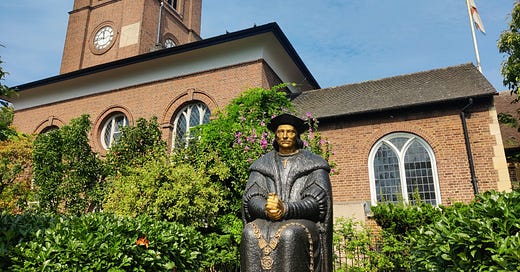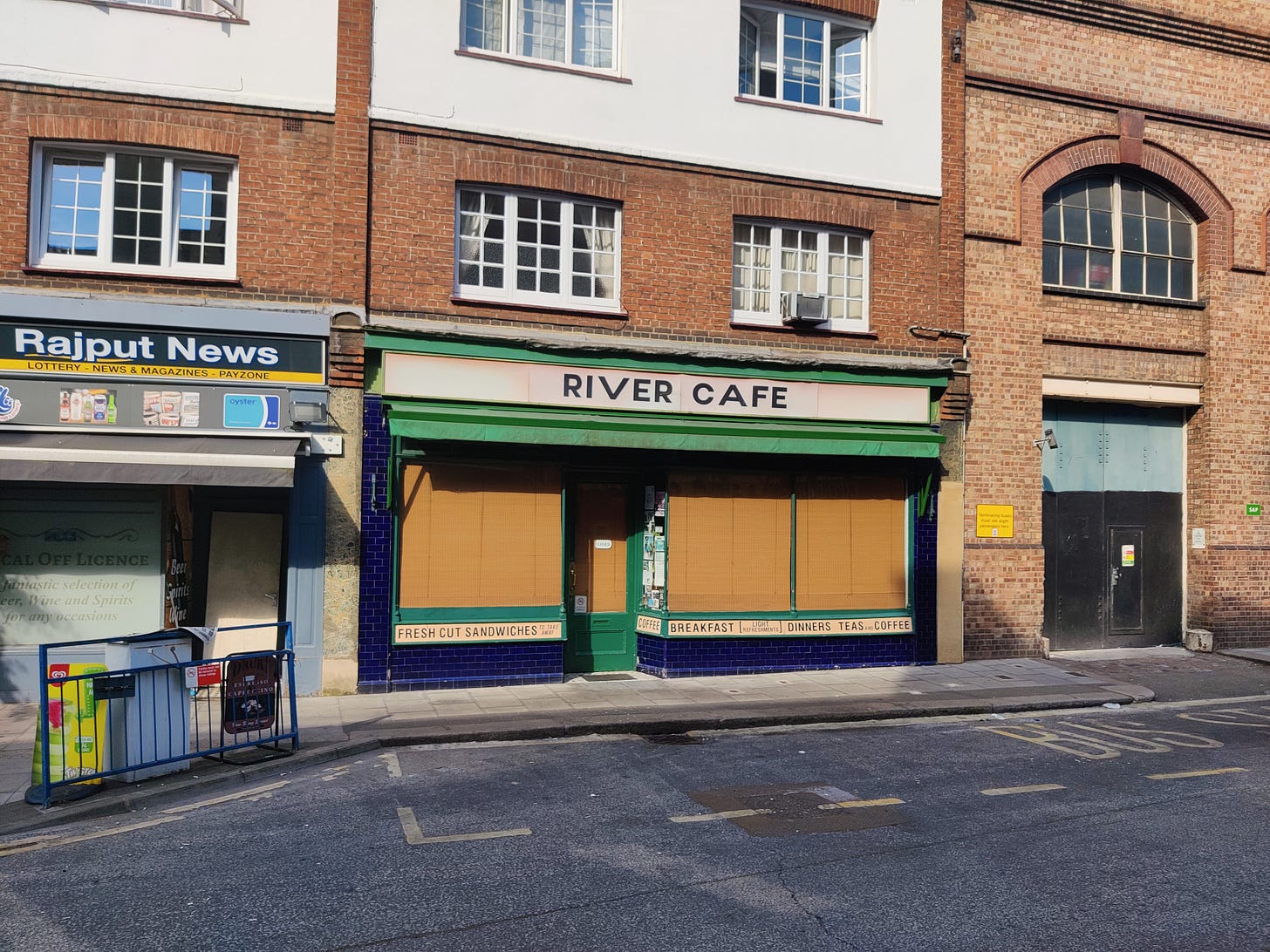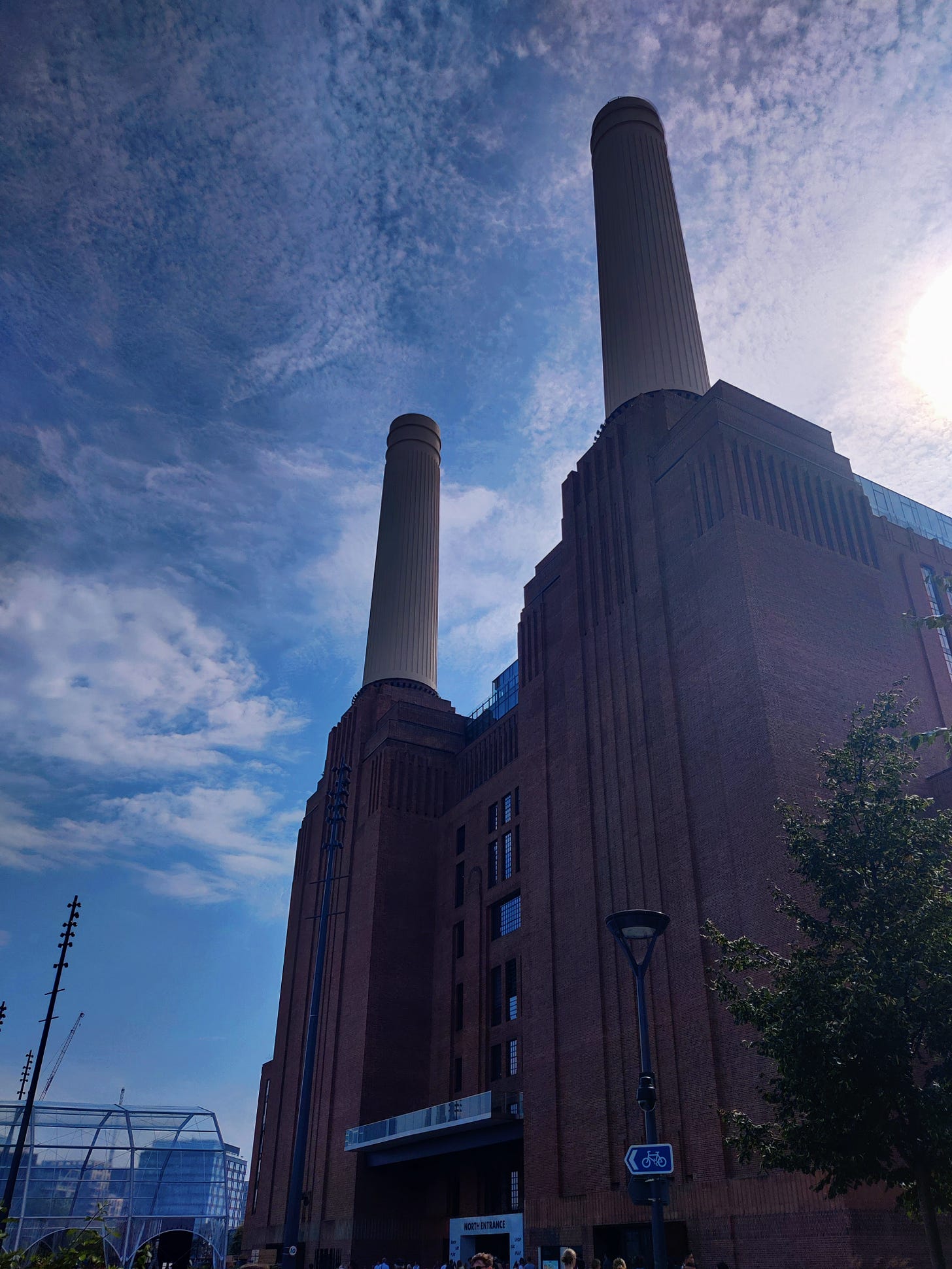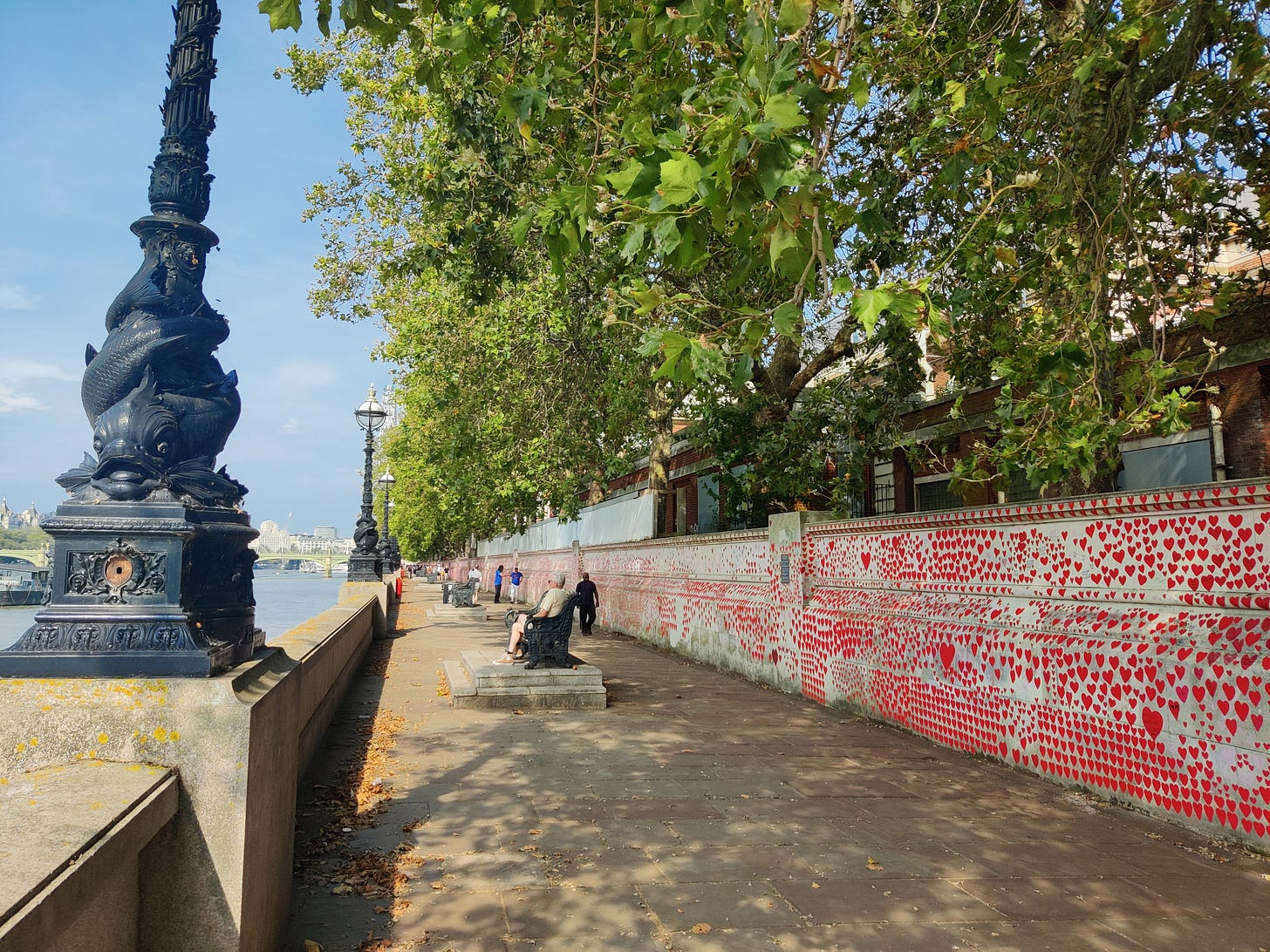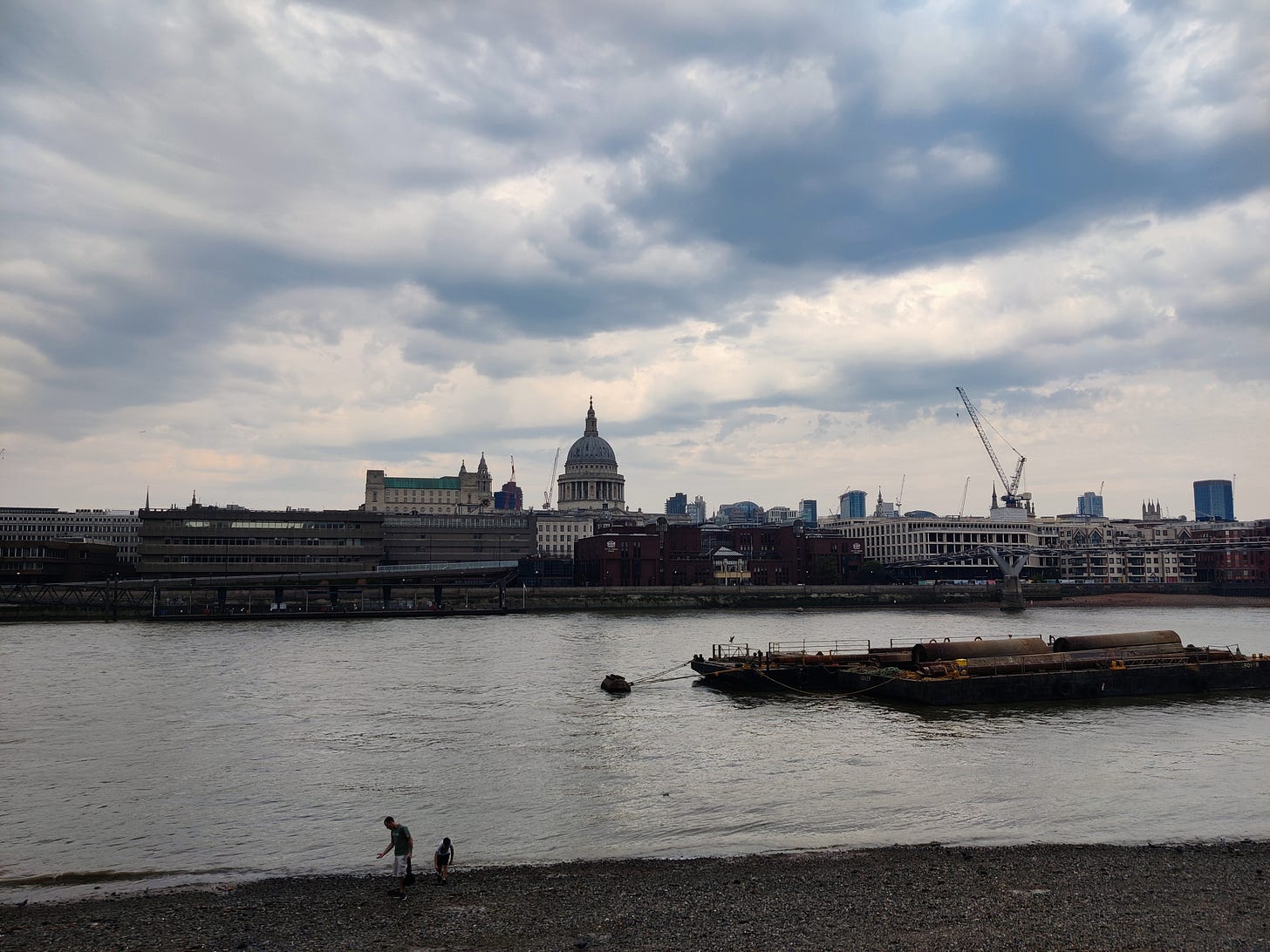Old Father Thames: Walking from Source to City... Chapter Thirteen
Trip Five, Day Two: Putney to Tower Bridge
(Catch up on the previous chapter: Here! )
‘This music crept by me upon the waters’
And along the Strand, up Queen Victoria Street.
O City city, I can sometimes hear
Beside a public bar in Lower Thames Street,
The pleasant whining of a mandoline
And a clatter and a chatter from within
Where fishmen lounge at noon: where the walls
Of Magnus Martyr hold
Inexplicable splendour of Ionian white and gold.
-T.S. ELIOT, THE WASTELAND
Sunday morning, and our penultimate day of the journey, saw us return by tube to Putney. Walking past the shuttered and sunbleached shops outside the elevated Putney Bridge station, we crossed the river and began our walk further into the centre of London.
All Saints Fulham and St Mary’s Putney sit on either foot of Putney Bridge, North and South respectively. Both fine medieval churches speak of a time when river bridges were sites of spiritual potency. Before the Reformation, virtually every bridge, from Lechlade to London, would have possessed a shine, a crucifix, or even a small chapel suspended over the waters. The churches which line the course of the river today often mark crossing points, be they ferries or bridges, defunct or still in use. The most interesting of these two particular churches is Putney, in the full flow of Sunday service when we pass, it has a proud place in the history of radical politics. On the 28th October 1647 commanders and officers of the New Model Army met in St Mary’s and began what became known as The Putney Debates. The project was to thrash out what form the government of England and Wales might take after the defeat of King Charles I. The King was, at the time, in the army’s custody and, so Cromwell believed, the war was entering its final stages, so plans for a new constitution became a key concern. The Army, despite nominally serving parliament, had performed what was essentially a coup and excluded the MPs from the discussions about the country’s future.
The debaters fell into two groups. The generals and commanders were in favour of more moderate reform, keeping Charles as head of state but dramatically curtailing his powers by a strict form of constitutional monarchy, giving parliament the ultimate say in the running of the country. Against them stood the radicals, mostly from the lower ranks of the army and led by Colonel Thomas Rainsbrough. These ‘Levellers’ advocated for dramatic change to politics, literally a levelling out of society, an end to any aristocracy and exploitative feudalism, equality under the law, universal voting rights and religious tolerance. Transformative ideas even by today’s standards but even more utopian in the mid-seventeenth century. After just thirteen days of heated discussion, Generals Oliver Cromwell and Thomas Fairfax, fearful that the voicing of these powerful radical sentiments might result in their own demise, shut down the Putney Debates on the 8th November - and with them any chance of the Leveller demands being met for over 250 years…and even to some extent today their convictions remain unfulfilled. It was during the debates that Rainsborough, uttered these now famous words:
“I thinke that the poorest hee that is in England hath a life to live as the greatest hee; and therefore truly, Sir, I thinke itt's cleare, that every man that is to live under a Governement ought first by his owne consent to putt himself under that Governement…”
A year to the day later, he was assassinated by royalist sympathisers at an inn near Doncaster, he is buried just downstream at another Thames-side church, St John’s, Wapping.
After leaving Putney, we enter Wandsworth and before long encounter the borough’s namesake, the river Wandle. An entirely urban tributary, it runs from the South London suburb of Carshalton, through Croydon and Wimbledon to the Thames, a total of nine miles. Izaak Walton mentions the quality of the fishing in The Compleat Angler (1653) and Lord Nelson used to spend so much time fishing its waters that his Mistress, Lady Hamilton, renamed the stretch that ran through her garden to ‘River Nile’ in honour of her lover’s great naval victory. The upper reaches of the Wandel used to power the Liberty fabric mills which provided the highly patterned designs for the eponymous department store. Today it is one of the country’s most polluted waterways, the fish long departed, and we cross its mouth as it muddily slides into the Thames between a warehouse and a refuse collection plant.
After skirting a number of industrial estates and business parks, we are able to keep to the riverside thanks to a paved path provided by the developers of various post-modernist housing developments which line the Thames between Wandsworth and Battersea. Each is named for a spice or luxury which might have been unloaded at the quays of London at the height of empire; Juniper Drive, Ivory Square, Molasses House, Cotton Row. These are only interrupted by the handsome Georgian church of St Mary’s Battersea, sitting unexpectedly right on the river bank and surrounded by weeping willows. First built in 800, and one of the oldest Christian sites in South London, the present building dates from 1777 and has connections with two great British artists, William Blake married his wife Cathrine Boucher here and a few years later the local lad J.M.W. Turner painted the river from the vestry window. In the vaults beneath you can find the tomb of Benedict Arnold, an American-born soldier who, after rising to the rank of Major General during the American Revolutionary Wars, defected to the British and ultimately returned to the US to fight against the very soldiers he had previously commanded. Another service is just finishing as we pass the church and, outside, a Citroen H van selling coffee awaits the coming rush of parishioners.
At Battersea Bridge, we cross to the North bank and briefly pause at the statue of painter James Abbott McNeill Whistler, who stands proudly at the foot of the bridge. His house (and incidentally, next door, that of Isambard Kingdom Brunel) is on the embankment here and he made the view of the Thames at night a particular focus for his work. Although born in Massachusetts, Whistler spent his whole working life in London, shocking and revitalising the stolid Victorian art world with the provocative modernity of his paintings. A staunch anti-Pre-Raphaelite, Whistler advocated for ‘art for art’s sake’, rather than a reliance on moralising or didactic meanings to be found in every painting. He equated his painting with the abstract quality of music, titling works Symphony in White No.1, Harmony in Red, and Variations in Pink and Grey. From his home on the Chelsea embankment he painted a series of ‘Nocturnes’ - nighttime images of the murky river and the misty sleeping city under the stars. Using a monochromatic palette and mixing plenty of water into his paint, these images seem to be moulded from the very river and tidal mud that they represent.
Just across the road from Whistler’s house is the historical patchwork called Crosby Hall. At its core is a fifteenth-century merchant’s house which, until 1910, occupied a site at Bishopsgate in The City. In its original location the building was home to Richard III, and is mentioned in Shakespeare’s play of the same, Catherine of Aragon, Sir Thomas More, Sir Walter Raleigh and even played headquarters for the East India Company in the early seventeenth century. By the late nineteenth century, the building was awkwardly surrounded by the Victorian city and, despite being regarded as the most important medieval domestic building in England, was scheduled for demolition make way for a bank. After protests by the National Trust, the British Archeological Society, and even Edward VII, the hall and its complete interior were moved, brick by brick, to its present site in Chelsea. Most of the original medieval core is now obscured from the street by a complex of mock Tudor and Stuart buildings which, during the twentieth century became home to Belgian refugees of the First World War and later the Federation of University Women. In the 1980s the local authority sold off Crosby Hall to the businessman Christopher Moran. He has now expanded the complex further, sealing off the previously public gardens, and emblazoned his family crest with mock-Tudor flare all over the facade. He has even built an elaborate faux-gothic tomb, complete with marble effigy, ready for himself in the chapel.
The reason for the hall’s relocation to Chelsea is Sir Thomas More. One time resident, he also owned land by the river here and is memorialised in the handsome redbrick church next door to the hall’s current site. Scholar, writer, politician and patron, Thomas More may well be one of the most cultured men England has ever produced. In tune with the learning and styles of the continental Renaissance, More’s novel Utopia is still read today as are many of his letters to the humanist scholar Erasmus of Rotterdam. A staunch Catholic and Lord Chancellor of England and Wales, his fall from grace was as dramatic and sudden as Henry VIII’s break with Rome. More lost his office, his home, and, ultimately, his head. Today, he is venerated as a saint in the Catholic church. More’s private chapel is in the church here, and we linger outside the open door, listening to the final hymns of that morning’s service echoing out into the Sunday morning traffic. In the graveyard, a large stone urn marks the tomb of Sir Hans Sloane, doctor to Queen Anne, and both George I and II, he is also credited with the invention of chocolate milk (although it is more likely he took the recipe from Jamaican natives on a visit to the Caribbean). Sloane’s estate in Bloomsbury and his extensive collection of books, antiques, and specimens, were donated to the nation after his death and subsequently formed the foundation of the British Museum.
We had considered popping into the Chelsea Physic Garden, a pretty walled garden which was founded by Sloane and contains a wide variety of medicinal plants, as well as a cafe which had come highly recommended. However, when we arrived at the small door which led into the walled acre, the £14 entry fee, even just to use the cafe, was sufficient to deter us and we carried on towards Chelsea Hospital, passing Tite Street. London’s streets are full of blue plaques and the homes of great figures in history, but Tite Street may hold the best ex-residents list of them all. This includes, though is not limited to, artists John Singer Sergent, Augustus John, Glyn Philpot, John Collier, and Whistler; composer Peter Warlock; writers Radcliffe Hall and Oscar Wilde; Rolling Stone Mick Jagger, and Squadron Leader Roger Bushell, the mastermind behind the real-life Great Escape. There is barely enough wall space for all the blue plaques on this short, riverside, Chelsea street.
Nearby is the Royal Hospital, Chelsea. Now best known for its annual flower show, this proud institution still serves the function for which it was built in 1682. Charles II commissioned Sir Christopher Wren to design a complex for housing over 300 retired army veterans, effectively an enormous almshouse for members of the British Army who, by either age or injury, were no longer able to look after themselves. Here they could be provided for, as well as being given the bright red uniforms which they still wear, making the good works of the King very visible for all to see. Wren’s grand yet martially spartan buildings still impress today as they dominate the gardens running down to the Thames.
Another building which dominates this part of the capital is Giles Gilbert Scott’s Battersea Power Station. Although now famous for its four-chimney silhouette, it began life in the thirties as only a two-towered structure, and remained so until 1955 when the size was doubled and the iconic skyline archived. Its sibling downstream, Bankside Power Station was transformed after closure into Tate Modern, now the most visited art gallery in the world, but for years Battersea remained a derelict hulk on the river bank. Last year the building opened its doors to the public for the first time, now transformed not into a museum or a gallery, not a community centre, sporting venue, or social asset, but instead into an enormous multi-billion pound shopping centre, full of the same brands than can be found on every London high street. On top of this, quite literally on the levels above the shopping, are over 500 luxury apartments which are way beyond the means of 99% of the population. Around the main building, amongst the sparsely planted gardens, are a number of further retail opportunities and apartment buildings by a choice of ‘starchitects’, including some box-ticking exercises in architecture by Frank Gehry and Norman Foster. What Johnathan Meads would call ‘site-bites’, the bricks and mortar equivalent of a meaningless sound-bite, these tall exorbitant structures have totally obscured the power station from the south London suburbs behind, thereby stealing from them a landmark which was all their own for more than two generations.
We pass briskly through the uncannily new wilderness of Battersea Power Station, which seamlessly flows into the equally soulless Nine Elms. The skyscrapers built here in the last decade all squeeze between the river on one side and the main line out of Waterloo on the other, creating glass and steel ravines that hide just a few vestiges of the older neighbourhood - the New Covent Garden Market is here, where the flowers and fruit sellers thrown out of the West End now ply their trade. Squatting at the heart of this new development, and the spring from which a lot of this development flows, is the brand new United States Embassy. Departing from their stylish home on Grosvenor Square, and selling off the old embassy to a Qatari developer who plans to turn it into a luxury hotel, the US has moved into an enormous glass cube with a clear view of the comparatively diminutive Palace of Westminster across the Thames - metaphor abounds.
Finally breaking free of Nine Elms, we cross Vauxhall Bridge and, passing Tate Britain, the site of the old Millbank Prison from which hundreds of prisoners were transported down the Thames to Australia, we enter Westminster. Crossing the river again on Lambeth Bridge, we walk the perimeter of Lambeth Palace, the London home of the Archbishop of Canterbury, and its neighbour St Thomas’ Hospital. To our left, across the water is the ever-impressive Palace of Westminster, capped off at the far end with the freshly resorted ‘Big Ben’. It is one of the largest and most pleasing gothic fantasies in the world, built to replace the old complex of buildings which burnt down in 1834, it is now at serious risk of burning down again unless major restoration work is allowed to take place. As ever, the politicians prevaricate on the issue.
However, to our right, running along the river walk, is an eight-foot wall absolutely covered in painted red hearts, almost all of them with a name or a message inscribed. The still unofficial, National Covid Memorial wall displays a heart for every life lost in the UK to the global pandemic of 2020-21. Directly facing off the Houses of Parliament across the river, recriminating the deadly failures of the Conservative government, and acting as a constant reminder to those across the water of the real human impact of the decisions they make every day. The whole thing is technically an illegal act of graffiti, however, nobody in either City Hall or Westminster has the gaul to powerwash it away since it has become the focus of national mourning.
A full account of the relationship between The Thames and central London would take more words than I have yet written since the source and so I will not attempt to detail the extraordinary history of every inch of each bank between Westminster and Tower Hill (although I may return to this subject in future), suffice to say that no city lives with its river in quite the way that London does. The Thames is unthinkable without the city and the city is impossible without the Thames, they created, and continue to create, each other. We stopped briefly for a coffee at the Festival Hall before browsing the secondhand book stalls which live under the southern foot of Waterloo Bridge. Across the river is Somerset House, a historic site in its own right but particularly so for me being the home of my alma mater, The Courtauld Institute of Art, and also where I lived when I first moved to London. Often I would make a cup of coffee in the kitchen of my halls and wander down to Waterloo Bridge with it, walking against the flow of commuters, to see the view east over the river to St Paul’s or west to Parliament.
On this sunny Sunday at the tail end of the summer tourist season, London’s Southbank is heaving with a crowd speaking in a hundred different tongues and dialects. Some queue for the London Eye, others stand by street food vendors, and more bunch near street performers presenting everything from gospel singing to acrobatics and fire eating. Whilst many decry this side of London as the ugly result of a city strangled by mass international tourism, one cannot deny that the almost permanent carnival atmosphere of the Southbank through the summer months shares a good deal with the medieval frost-fairs or the eighteenth-century pleasure gardens which have always been a part of London’s riverside life. The public displays of food, drink, music and the merriment of crowds from every race and religion are as much a part of the capital as red buses and black cabs, more so in fact, for they were here long before the London Underground and the red phone box.
We continued along the south bank of the Thames, passing Tate Modern, Shakespeare’s Globe Theatre, Southwark Cathedral and Borough Market, until we crossed London Bridge. This was the site, more or less, of the first bridge across the Thames built by the Romans, and all of the subsequent structures including the medieval bridge which was lined with homes and shops. Until Putney Bridge, where we started today, was built in 1729, this was the only bridge downstream of Kingston. The current iteration opened in 1973 after the previous Victorian-built bridge was sold to American oil tycoon Robert P. McCulloch and shipped over to the US brick by brick to be reconstructed in the Arizona desert. I took Dad to the porch of St Magnus the Martyr church, a wonderful Wren church by the river, to show him the half-fossilised chunk of wood salvaged from the bed of the river and supposedly a part of the original Roman bridge.
Having touched the first and last London Bridges, we walk the final mile or so, past the original Billingsgate Fish Market to the Tower of London and the end of today's walk. Tomorrow morning we will return to The Tower for our final day walking the river, taking us through the east London docklands, past the majesty of maritime Greenwich to the tidal barrier at Woolwich where our walk will end.
Next time: The White Tower…Pilgrim Fathers…tunnelling under the waters…the goats of Canary Wharf…Wren, Nelson, and the Millenium Dome
(Thank you for reading! If you enjoyed, please consider subscribing to get all future instalments sent straight to your email inbox. You can also choose to support my writing (and walking) by choosing a paid subscription option.)


